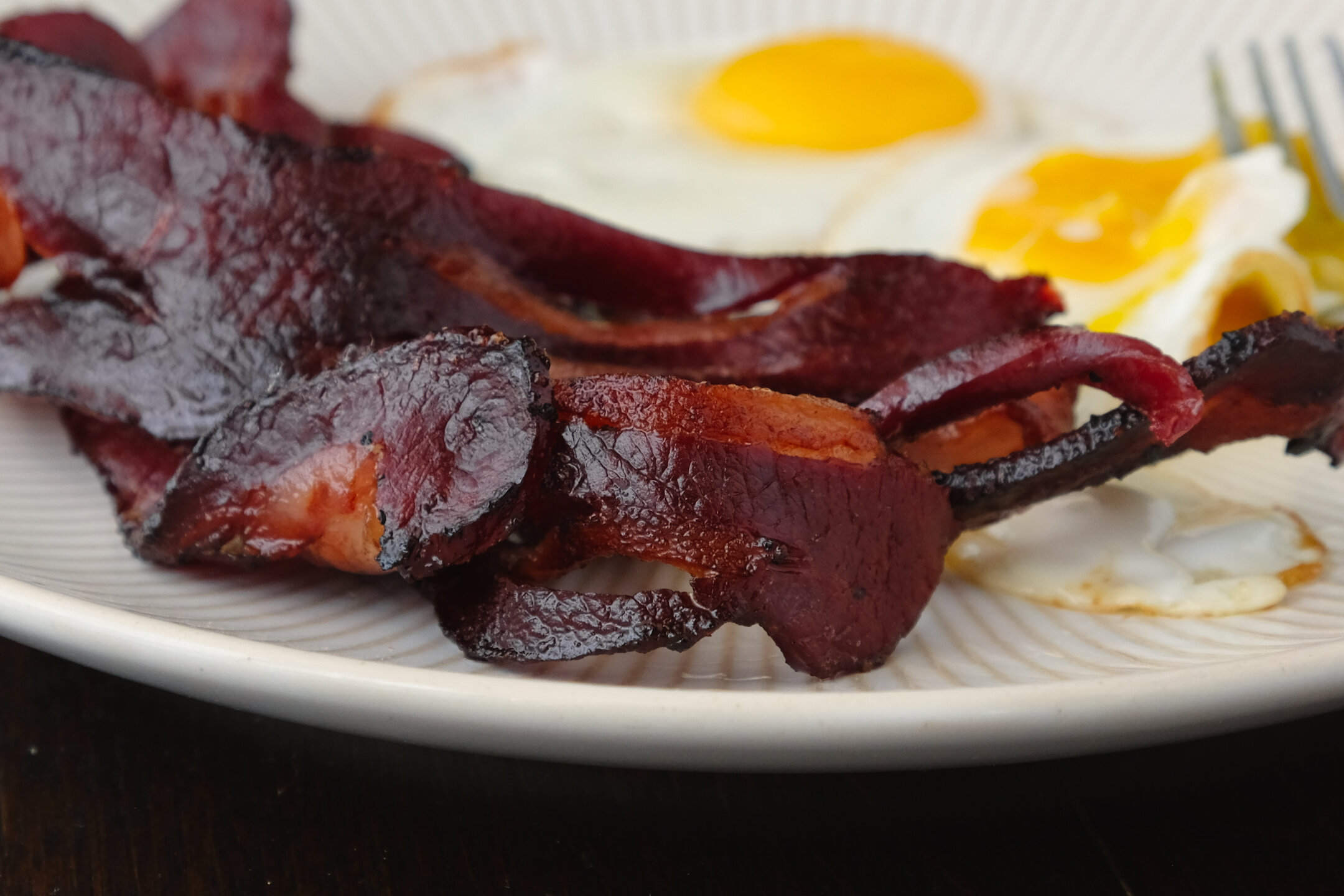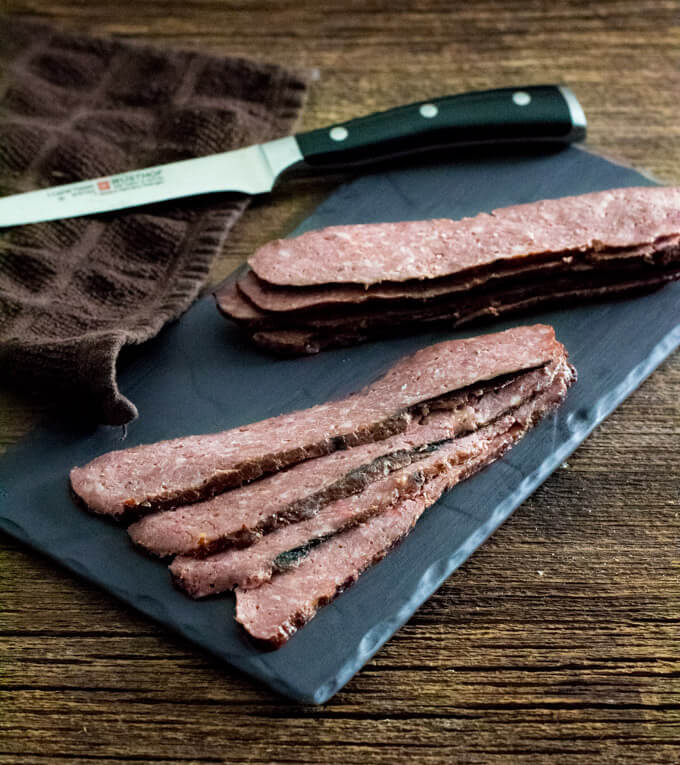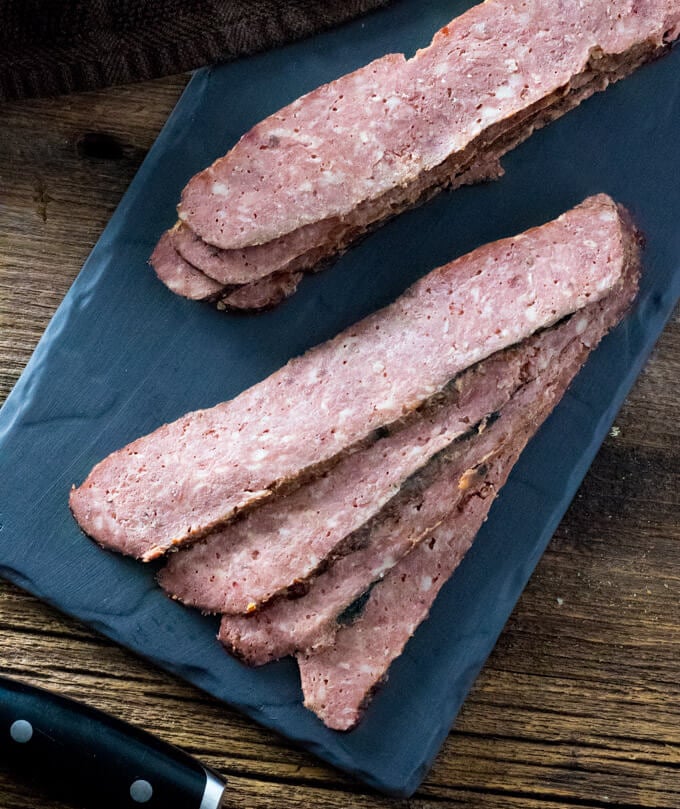If you season, cure, and smoke ground venison and pork fat, you can make venison bacon, which is sweet and smoky sheet bacon.
This recipe has been on my to-do list for a long time. People who like to hunt really like venison bacon, but I could never find a recipe for how to make it. I could only find ready-made cure mixes that I had to buy. For people like me who are proud to kill their own animals and make everything from scratch, that wasn’t okay. So I set out to create this recipe.
Venison bacon is made from ground meat instead of a whole cut of meat like pork belly in regular bacon. It is also sometimes called “formed ground bacon.” It is prepared and cooked like venison sausage, but loaded with bacon seasonings and thinly sliced.
Deer bacon is a delicious treat for hunters and foodies alike. But venison bacon can be tricky to cook just right since it’s leaner than pork bacon. Undercook it and the texture is unpleasantly mushy. Overcook it and you end up with bacon bits charred to jerky. So how do you know when venison bacon is perfectly done? Read on for tips on identifying doneness based on sight texture temperature and taste.
What is Venison Bacon?
Venison bacon is made from deer meat rather than traditional pork belly. Since deer meat is extremely lean, venison bacon recipes call for adding some fatty ground pork to help mimic the mouthwatering crispiness of regular bacon. The pork content usually ranges from 30% to 50%.
Venison bacon is flavored and preserved using a dry cure mixture containing salts, spices, sugars, and sodium nitrite curing agents. This imparts the characteristic smoky, salty bacon taste. The cured venison mixture is then smoked at low temperatures before being cooked.
Signs Your Venison Bacon is Undercooked
It can be challenging to pinpoint when lean venison bacon is perfectly cooked and not underdone Here are a few ways to tell if your deer bacon needs a bit more time
-
Very pink, moist interior color – Should have some browned exterior with pinkish-tan interior when done.
-
Soft, squishy texture – Properly cooked venison bacon feels firm yet slightly pliable.
-
Lack of grease pooling – Finished bacon will release some fat during cooking.
-
Raw, gamey flavor – Fully cooked venison bacon has a balanced smoky, salty taste.
Err on the side of slightly under rather than overcooked since you can always cook it a bit more. Slightly undercooked bacon just needs a few more minutes to finish.
Clues Your Deer Bacon is Overcooked
It’s easy to go too far when cooking venison bacon and end up with bacon that’s gone past perfectly done to overly crispy. Watch for these signs you may have overcooked the venison bacon:
-
Very dark brown or blackened areas – Ideal color is golden brown.
-
Dry, brittle texture – Properly cooked bacon should be able to bend without breaking.
-
Curled, shriveled slices – Excess shrinking indicates overcooking.
-
Intense smoky or burnt flavors – The taste should be well balanced.
Unfortunately overcooked venison bacon can’t be salvaged. It’s best used as bacon bits for adding smoky flavor versus eating strips.
Ideal Internal Temperature
Using an instant read thermometer takes the guesswork out of determining doneness. Venison bacon should register these internal temperatures when done:
- 150°F for pliable strips
- 160°F for crisper texture
Check temperature towards the thickest part of slices. Make sure to clean thermometer tip in between tests to avoid cross contamination.
Judging Doneness Visually
Cooking venison bacon in a skillet makes it easy to gauge doneness just by looking. Perfectly cooked bacon should exhibit these visual cues:
-
Golden brown exterior color on both sides – Not too light or too dark.
-
Some fat rendering on the surface – But not completely grease-drenched.
-
Moderate meat shrinkage – Around 20%, not tightly shriveled.
-
Slight curling at edges but still mostly flat – Not drastically curled or rigid.
Trust your eyes. The bacon’s appearance directly correlates to its level of doneness.
Monitoring Changes in Texture
Texture transforms gradually during cooking from raw and mushy to perfectly firm and crisp. Track these stages:
-
Raw – Squishy, loose, excess moisture
-
Partially cooked – Spongy, becoming firmer
-
Nearly done – Tightening, more structured
-
Perfect – Firm yet still pliable, not brittle
-
Overcooked – Hard, dry, starts splintering
Poke strips with tongs or fork periodically to continually assess texture. Just be gentle to avoid breaking.
Performing a Bend Test
You can gauge doneness through a simple bend test. This checks pliability correlating to cooked level:
-
Raw – Floppy with no structure
-
Undercooked – Quite pliable but starting to firm
-
Perfect – Holds its shape but still bends easily
-
Overcooked – Rigid, breaks instead of bending
Carefully pick up an edge and bend. It should flex slightly but not snap in two if fully cooked.
Tasting for Seasoning Balance
Bite a tiny corner to check taste. Undercooked bacon tastes very gamey. Perfectly done venison bacon offers a harmonious blend of smoky, salty, sweet and meaty flavors.
Overcooked bacon intensifies smoky and bitter notes. Taste testing confirms what texture and appearance indicate.
Let Resting Complete Cooking
After removing venison bacon from the pan or oven, let it rest 5 minutes. Residual heat finishes cooking the interior slightly more. And resting allows moisture to redistribute for a juicy bite.
Properly cooked venison bacon is safe to eat and offers the best texture. Mastering the visual, touch and temperature cues for perfection takes practice. But with a few batches under your belt, you’ll be a venison bacon pro.

Does Venison Bacon Taste Like Bacon?
Venison has a distinctly different flavor than pork which will be reflected in the bacon. However, venison bacon does have the same traits as traditional bacon – wonderfully sweet, smoky, and salty!.

Equipment Needed for Venison Bacon
There are affiliate links in the list of things you need to make venison bacon that let you quickly and easily buy the same things I use from Amazon.
- Stick smoker—You can use a regular oven to make deer bacon, but smoking it will make it taste better. It is best to use an electric smoker for making any kind of sausage because it lets you control the temperature more precisely as you raise it gradually during the cooking process.
- Deli Slicer: Once the bacon is done smoking, you can use your chef knife to cut it into thin slices, but a deli slicer is much faster and easier to use. You can also use it to cut my smoked rump roast recipe into thin slices.
- Meat Grinder: You will need to use a meat grinder to grind your deer brains into bacon that is already formed. Read my How to Butcher a Deer tutorial for tips on how to grind deer meat.
Most likely, you don’t keep a few of the things you need for venison bacon on hand if you don’t usually make bacon or sausage.
- Curing—The meat needs to be cured because it will be cooked at very low temperatures for a long time. The cure stops dangerous bacteria from growing in the meat while it cooks, making it safe to eat. You can buy a lot of different cures. Always read the label to make sure you use the right amount.
- Dairy-Free Dry Milk Powder: You can get this at any grocery store. It is added to sausage to keep it together, keep the moisture in, and stop it from shrinking while it’s cooking.
- Brown Sugar—Smoky and sweet is the classic bacon pair. The brown sugar gives the meat a great sweetness and makes a sticky glaze on the outside. Feel free to add/substitute maple syrup as well.
- Ground Venison—I use a mix of ground venison and pork fat to make venison bacon. Somewhat less than 80% lean meat and 20% fat is a good starting point, but you can go as high as 30% fat if you want to. Make sure you don’t lose more weight than you need to, or your bacon will taste dry and lack flavor. If you had a butcher process your deer meat, you can ask them what fat ratio they used.

How to Make Venison (Deer) Bacon at Home | The Bearded Butchers
FAQ
How do you know when venison bacon is cooked?
How to know when venison is fully cooked?
How long does it take to cook venison?
|
Venison cut
|
Suggested method
|
Approx. cooking time (rare)
|
|
Roasts
|
Sear, then oven roast at moderate temperature
|
15 minutes per 500g @ 180C
|
|
Diced venison
|
Sear, then gently casserole at low temperature
|
1 hour @ 100C
|
|
Frenched racks
|
Sear, then finish in the oven at 180C
|
10 minutes per 500g @ 180C
|
Can you eat venison medium-rare?
